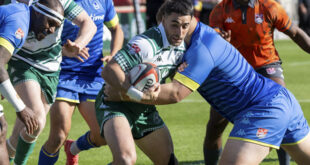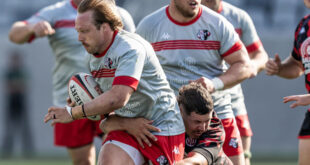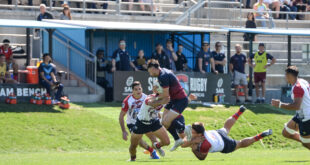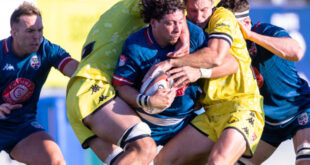PNC… Leave it Be
The Pacific Nations Cup is coming off a very strong Round 2 that saw an epic battle between Samoa and Fiji as well as a thrilling upset for the USA over Japan. The tournament, often adjusted, could very easily turn into a great annual tournament for all of the sides involved.
That is… if World Rugby would just stop changing it. The six teams in place are a good fit right now. Let them all stay there under the same format for at least a few years and see how it goes.
The tournament has arguably been changed and adjusted more times over the years than any other tournament on the World Rugby calendar. There is excitement about the upcoming Americas 6 Nations, but the USA and Canada have always had the PNC right there waiting to become a much bigger tournament than it has shown. Unfortunately, we’re probably never going to see the PNC be more than a 2-3 week quickie.
Fiji vs Samoa
If you didn’t get to see the Fiji/Samoa dual, please go to ESPN 3 and watch the replay. The match was the most enjoyable 80 minutes of rugby that I’ve seen this year and possibly one of the Top 5 games I’ve watched in the past few years. Both sides play physical and enterprising rugby. They went toe to toe and ended with a fitting 30-30 tie. An amazing display of rugby fun.
It is unfortunate that both nations have been through administrative turmoil and are under supported financially. If they had half the budget of some of the big nations, I firmly believe that both Samoa and Fiji could push the Top 5.
Go out and watch the game. You will not be disappointed. Seriously… go watch. If you’ve already seen it… watch it again if needed.
USA Pips Japan
In a World Cup year it is hard not to read into every match or subplot. It’s only natural. The USA’s win over Japan, their first over the Asian side since 2003, was important for the psyche of the Eagles. However, it’s hard to believe that Japan’s Head Coach Eddie Jones showed much of his hand in the USA’s 23-18 victory. When the two sides meet in England this Fall, things could be much different.
On the other hand, it is easy to assume that the Eagles threw everything they had at Japan. In the minds of most of the rugby world, that’s probably what they would believe as the only reason the USA could beat Japan, a side that cracked the Top 10 earlier this year for the first time in their history. While USA Head Coach Mike Tolkin isn’t known for his tactics, don’t be surprised if the Eagles weren’t showing their full hand either.
Which makes things all that much more interesting.
The real story coming out of Sacramento is the job put in by the Eagle forwards. The forwards were the key to the USA’s victory. The forwards took on Japan, scored the winning try, and repeatedly forced Japan into penalties which were the key to AJ MacGinty’s six penalty goals that kept the USA in the game. Here’s a look at each position, forwards and backs, and how they fared against Japan.
Front Row – The match started off strong for the front row. Eric Fry, Zack Fenoglio, and Titi Lamositele anchored the first scrum of the match and held ground for most of the first half. Unfortunately, Japan changed some tactics in the second half and started to remind the American fans of past scrum troubles. For the first part of the second half, the Eagles were pushed around and penalized at the scrum. The icing on the cake was when Japan walked in a try from a 5-meter scrum. Then, out of nowhere, the USA reclaimed the scrum and held strong for the remainder of the half. The pivotal moment at the end of the match saw Japan with a 5-meter scrum. Instead of pushing it in, the Eagle pack held strong forcing Japan to play the ball which led to USA winning a penalty and the match. What we saw happen was the US scrum make adjustments of their own. Japan was expected to dominate the USA in the scrum. Aside from a 15 minute span in the second half, they did not. This is a very encouraging sign. Fry and Lamositele may have locked in their starting roles for the World Cup with this most recent effort. Both were strong in loose play and if the scrum continues to progress, then the USA might make things interesting the rest of the year. Fenoglio was decent and got involved on offense, but the USA’s lineout tightened up when Phil Thiel came on in the final quarter of the match.
Second Row – With a new pairing in Cam Dolan and Hayden Smith in the second row, Tolkin was experimenting a bit. Dolan is capable of playing second row, but had done little. Any questions were answered as Dolan showed that he could be the Eagles best lock. Both Smith and Peterson have looked unfit during their first two matches of the season. They have played solid defense, but shown little in attack. Dolan is one of the most athletic players on the team. While he made a few mistakes with ball in hand, there is no doubting he could be an impact player. Louis Stanfill came on as a late sub and turned up the intensity for the team.
Back Row – After showing well at the end of the Samoa match, Andrew Durutalo was given the start against Japan. He responded with a top notch performance that could vault him into contention for not only a spot on the World Cup side, but into a battle for a starting role. Durutalo was strong defensively and was one of the few Eagles that looked dangerous with ball in hand against Japan. As a player coming right off of sevens duty, Durutalo’s fitness is not in question one bit. His day was capped by scoring with winning try. Scott LaValla returned to the back row after playing in the second row against Samoa. LaValla was his steady self producing a high work rate, good work in the lineout, and a steadying presence in the pack. He also made one of the few breaks for the USA on offense as he nearly linked with Durutalo for a big play. Danny Barrett came off with a knock in the second half, but played well in the first half. He also produced one of the few Eagle line breaks… noticing a trend here? Al McFarland came on as his sub and played well. He produced a couple key penalties for the USA.
Halfbacks – Mike Petri got the nod at scrumhalf for his 50th cap in an Eagles jersey and played decently. Petri did well to try to use what quick ball was available, but his delivery appears to have slowed in the last year or so. A couple moments of indecision at the breakdown also resulted in turnovers. His kicking game, often criticized, was solid. A number of his kicks were reclaimed as they were designed to be. While the forwards did much of the work drawing penalties out of Japan, they would have been all for naught if there wasn’t someone there to convert them into points. In only his second start for the Eagles, MacGinty slotted six penalty goals and with them likely cemented his place as the Eagles’ starting flyhalf. Offensively, the USA struggled to break the gainline. The question is whether it was Petri/MacGinty or if Tolkin’s game plan to pound straight into the Japanese defense was purposely designed so as to not give much away?
Centers – As against Samoa, Thretton Palamo and Seamus Kelly were paired in the centers. The pair played physically on defense, but were both caught out of position multiple times. Their midfield miscommunication/misplay produced Japan’s highlight reel try off of a scrum. Offensively, the pair are strong runners, but have yet to produce the gains needed to get their opponents on the back foot.
Back Three – As with the Samoa match, Taku Ngwenya, Blaine Scully, and Chris Wyles had very little room to work with against Japan. Whether that is by design or lack of execution, all three are more than capable finishers. Without much ball to work with, the trio still managed to put in decent games. Scully remains a world class threat under the high ball. As against Samoa, he reclaimed possession on multiple kicks. Ngwenya also got into the kick chase mix as he put pressure on Japan. Wyles led from fullback and never seemed to fully get into the match.
USA/Tonga
The USA rolls out an entirely different lineup against Tonga this afternoon. I hate to use the phrase… throw away game, but this match is all about looking at the Eagles’ depth. Win or loss, this match is needed. We knew it was coming too. There was no way that Tolkin wasn’t going to experiment during the PNC. With the USA almost locked into 2nd place in their pool (there is a slim chance at them finishing 1st), now is a perfect time to play around with the roster.
The lineups we saw against Samoa and Japan are likely very close to the USA’s first XV. Now Tolkin needs to find out who wants to put their hands up to fill out the roster and provide good minutes off the bench.
Tune in this afternoon to see how it goes.
 Americas Rugby News Rugby news from across the Americas!
Americas Rugby News Rugby news from across the Americas!




